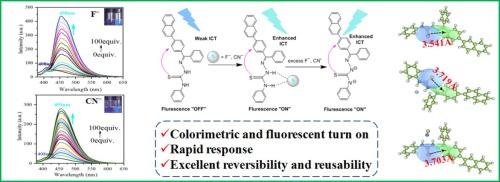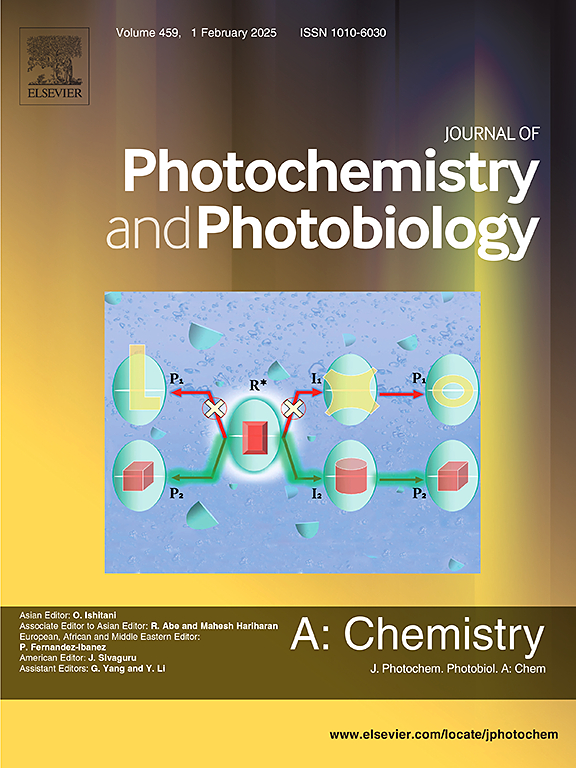基于信息和通信技术的新型 "开启式 "荧光比色传感器,用于检测氟离子和氰离子
IF 4.1
3区 化学
Q2 CHEMISTRY, PHYSICAL
Journal of Photochemistry and Photobiology A-chemistry
Pub Date : 2024-10-10
DOI:10.1016/j.jphotochem.2024.116069
引用次数: 0
摘要
我们合成了一种新型传感器(传感器 2),它含有芳香族萘的荧光核心和氨基硫脲基团的结合部位,并对阴离子的识别进行了系统研究。结果表明,传感器 2 在检测氟化物(F-)和氰化物(CN-)方面具有反应快、选择性高、灵敏度高和可逆性强等特点。在传感器 2 的二甲基亚砜溶液中加入 F-/CN- 会引起明显的颜色变化,在环境光下由无色变为黄色,在 365 纳米紫外光下由蓝色变为绿蓝色。此外,根据传感器 2 对 F- 和 CN- 的不同敏感度,传感器 2 可以通过荧光光谱区分 F- 和 CN-,并在不同的发射波长下 "开启"。通过 ESI-MS、1H NMR 滴定、DFT 和 TD-DFT 计算,提出并验证了传感器 2 与 F- 和 CN- 通过形成氢键和随后的去质子化作用的传感机理。还研究了传感器 2 的可逆性,证实它是一种可重复使用的传感器。此外,传感器 2 在检测牙膏中氟化物方面的初步应用也取得了成功。本文章由计算机程序翻译,如有差异,请以英文原文为准。

A novel “turn on” fluorescent and colorimetric ICT-based sensor for the detection of fluoride and cyanide ions
A novel sensor (Sensor 2) containing a fluorescent core of aromatic naphthalene and a binding site of aminothiourea group has been synthesized and systematically investigated with regard to anions recognition. The results indicate that Sensor 2 shows fast response, high selectivity and sensitivity and reversibility to detect fluoride (F−) and cyanide (CN−). Adding F−/CN− into DMSO solution of Sensor 2 induces a distinct color change from colorless to yellow under ambient light and from blue to greenish-blue under 365 nm UV light. Besides, Sensor 2 can distinguish F− from CN− by fluorescent spectra based on the different sensitivities of Sensor 2 to F− and CN−, as well as “turn on” at the different emission wavelengths. The sensing mechanism has been proposed and verified by ESI-MS, 1H NMR titration, DFT and TD-DFT calculations, which refers to the interaction of Sensor 2 with F− and CN− via forming hydrogen bond and subsequent deprotonation. The reversibility of Sensor 2 was also studied, confirming that it is a reusable sensor. In addition, the preliminary application of Sensor 2 for the detection of fluoride in toothpaste was successful.
求助全文
通过发布文献求助,成功后即可免费获取论文全文。
去求助
来源期刊
CiteScore
7.90
自引率
7.00%
发文量
580
审稿时长
48 days
期刊介绍:
JPPA publishes the results of fundamental studies on all aspects of chemical phenomena induced by interactions between light and molecules/matter of all kinds.
All systems capable of being described at the molecular or integrated multimolecular level are appropriate for the journal. This includes all molecular chemical species as well as biomolecular, supramolecular, polymer and other macromolecular systems, as well as solid state photochemistry. In addition, the journal publishes studies of semiconductor and other photoactive organic and inorganic materials, photocatalysis (organic, inorganic, supramolecular and superconductor).
The scope includes condensed and gas phase photochemistry, as well as synchrotron radiation chemistry. A broad range of processes and techniques in photochemistry are covered such as light induced energy, electron and proton transfer; nonlinear photochemical behavior; mechanistic investigation of photochemical reactions and identification of the products of photochemical reactions; quantum yield determinations and measurements of rate constants for primary and secondary photochemical processes; steady-state and time-resolved emission, ultrafast spectroscopic methods, single molecule spectroscopy, time resolved X-ray diffraction, luminescence microscopy, and scattering spectroscopy applied to photochemistry. Papers in emerging and applied areas such as luminescent sensors, electroluminescence, solar energy conversion, atmospheric photochemistry, environmental remediation, and related photocatalytic chemistry are also welcome.

 求助内容:
求助内容: 应助结果提醒方式:
应助结果提醒方式:


